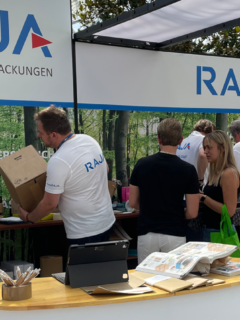0201, 0300, 0340 – mean anything to you? Or do 0712 or 0713 seem more like “007” to you? No, these designations are not code words from the latest James Bond film and “FEFCO” is not the abbreviation for some ominous secret language either! Rather, it has everything to do with the serious subject of boxes. FEFCO codes make a rather large and rather confusing market comparable. But how do FEFCO codes work exactly?
Continue reading:
More on FEFCO – More on carton manufacturing – More on customised cartons.
We encounter cartons everywhere
21.4 million tonnes – that’s how much paper, cardboard and cartonboard was produced in Germany in 2020, according to the Association of German Paper Factories. Almost half of this was used to make packaging. It is hard to imagine the packaging industry without cardboard as a material, and in almost every product area there are items that can be optimally packaged with it. At the same time, we encounter cartons almost everywhere in our daily lives. Whether as a milk carton in the morning at breakfast or as a book cover for evening reading – without cartons many things would be different.
Carton – word origin
The word “carton” actually comes from French. Here, “carton” means as much as cardboard box. However, the term has its origins in Italian. Thus, “cartone” is used as an enlargement of “carta”, which translated means paper. This is a first hint at the difference between paper, cardboard and paperboard. With a weight per unit area of 130 g/m² to 600 g/m², carton lies between the lighter paper (7 to 150 g/m²) and the heavier cardboard (from 600 g/m²). On the one hand, this makes the material particularly strong, but at the same time it remains flexible and easy to shape.
What is FEFCO?
As flexible and malleable as cardboard boxes are, the design possibilities of cardboard packaging are therefore just as varied. Anyone who has ever built or assembled a shipping package from cardboard may have noticed how much fiddling is involved. For example, there are punch-outs, folds, gluing and much more.
While this is practical and makes cartons versatile, it also makes communication between users, retailers and manufacturers difficult. For this reason, the European Federation of Corrugated Board Manufacturers decided in the 1960s to standardise the designations for cardboard boxes. This special coding is called FEFCO, which is now used internationally.
What does FEFCO stand for?
The abbreviation FEFCO stands for FédérationEuropéenne des Fabricants de Carton Ondule and refers to this federation of European associations of corrugated board manufacturers. As a non-profit organisation based in Brussels, FEFCO deals with all issues relevant to the corrugated packaging industry.
What is ESBO?
FEFCO is complemented by ESBO:European Solid Board Organization. These industry associations have defined an internationally valid code for the description of packaging materials and shipping packages made of corrugated board and solid board.
Sense and purpose of the code
The purpose of the FEFCO codes is to simplify and standardise communication about packaging between users, traders or manufacturers. This is because the FEFCO code can be used to classify cartons, boxes or crates into internationally common classifications.
This clear classification also enables easy trade between customers and manufacturers all over the world. The FEFCO-ESBO code makes it easy to avoid language-dependent misunderstandings regarding size, shape or design.
FEFCO has also standardised the technical drawings for folding boxes. This makes it clear at a glance where to fold inwards and where outwards, where to cut, score or glue. And always with one goal in mind:
To replace cumbersome definitions of corrugated box and packaging constructions with simple, internationally valid symbols that are generally understandable regardless of linguistic and other difficulties (FEFCO).
How is the coding structured?
With the FEFCO code, all boxes made of solid or corrugated board can be divided into different basic types. The four-digit FEFCO code number indicates the type of cardboard box. For example, 0201 is the classic folding carton made of corrugated board and 0300 stands for a multi-part carton with a lid.

But not only the general design of the packaging is indicated by this code, but also the exact design – for example, how the carton is closed. What this looks like can be seen in the case of the flash-bottom erecting carton: the 0712 carton has lid closure flaps, while 0713 is the carton variant with a tuck-in lid.
The FEFCO basic types
The first two digits indicate the basic type of the box. The FEFCO catalogue is divided into the following basic types:
| Basic types | Properties |
|---|---|
| 01- Rolls and sheets |
|
| 02 – Folding boxes |
|
| 03 – Lid boxes |
|
| 04 – Folded sleeves and trays |
|
| 05 – Sliding boxes |
|
| 06 – Rigid boxes |
|
| 07 – Ready glued boxes |
|
| 09 – Interior fittings |
|

Based on this, the various embodiments are brought into a uniform, internationally understandable FEFCO code system by means of further code numbers.
Made-to-measure boxes – just the way you need them
By adding logical graphic symbols and letters, each carton can be precisely defined. This is of enormous importance for the design and production of cardboard boxes. At the same time, FEFCO codes also make it possible to configure individual customised cartons.
Because there is an unbelievable selection of shipping packaging, postal packaging, bottle packaging, folding boxes and cartons that even we don’t have all of. However, with the help of the FEFCO code, you can configure your desired box step by step. In the process, every carton shape, no matter how unusual, is given a unique FEFCO number that can be used to describe it unambiguously and reproduce it as often as you like.
The way to the desired carton
It all starts with the customer’s order: this is where all the important details about the future use of the customised box are clarified. For example, should it be stackable, how will it be transported, how should it be sealed, how much moisture and what temperatures must it withstand – and, crucially, how sensitive is the product packed in it?
Based on this information, the development department designs a model on the computer and plans all the necessary dimensions directly. FEFCO codes facilitate this step enormously. Because the four-digit number means there are no misunderstandings about the shape or size of the desired box.
Gradually, both the FEFCO code and the gross box type take shape …



How a made-to-measure carton is created
An initial sample is produced on a plotter, which the customer receives with a quotation for inspection. If the delivered sample matches the customer’s wishes, the punching tools necessary for production are ordered after final approval and – if printing is desired – the corresponding clichés.
In production, the individual layers of corrugated board are then brought together and glued, then punched out and printed. There are various options for printing the finished board, depending on what is required: Offset printing is particularly suitable for gift boxes or displays. The motif is printed on a carrier film and then attached to the corrugated board body.
With screen printing, the respective image is again applied directly to the substrate to be designed with the help of stencils. Due to the somewhat longer production time, this method is particularly recommended for the design of smaller quantities. Flexo printing is the third option and the most frequently used printing method for corrugated board products. It is often used, for example, to apply logos directly to the packaging.
All relevant products in the FEFCO range
can be found in our webshop in our FEFCO Corner – and a small selection here:















